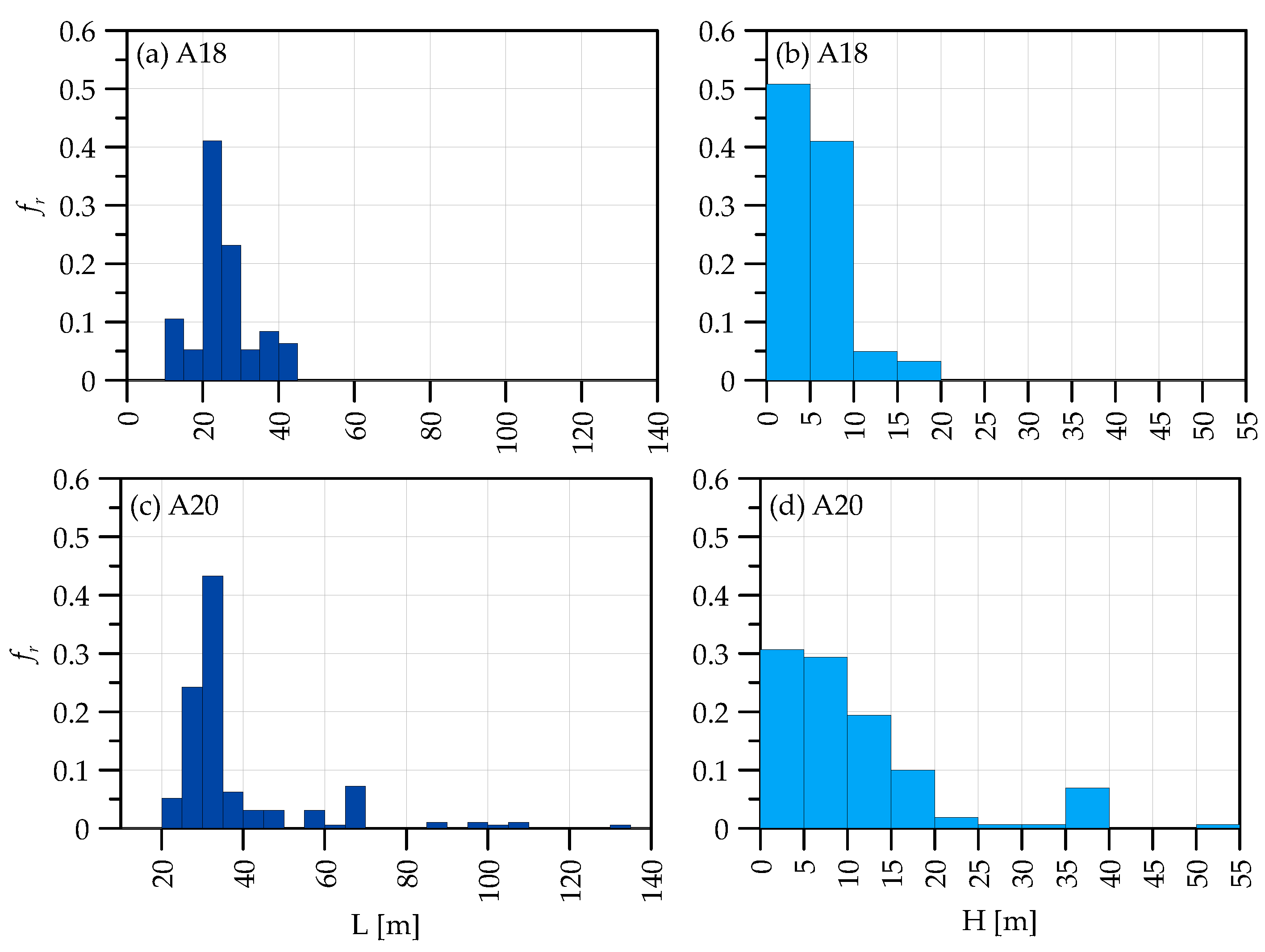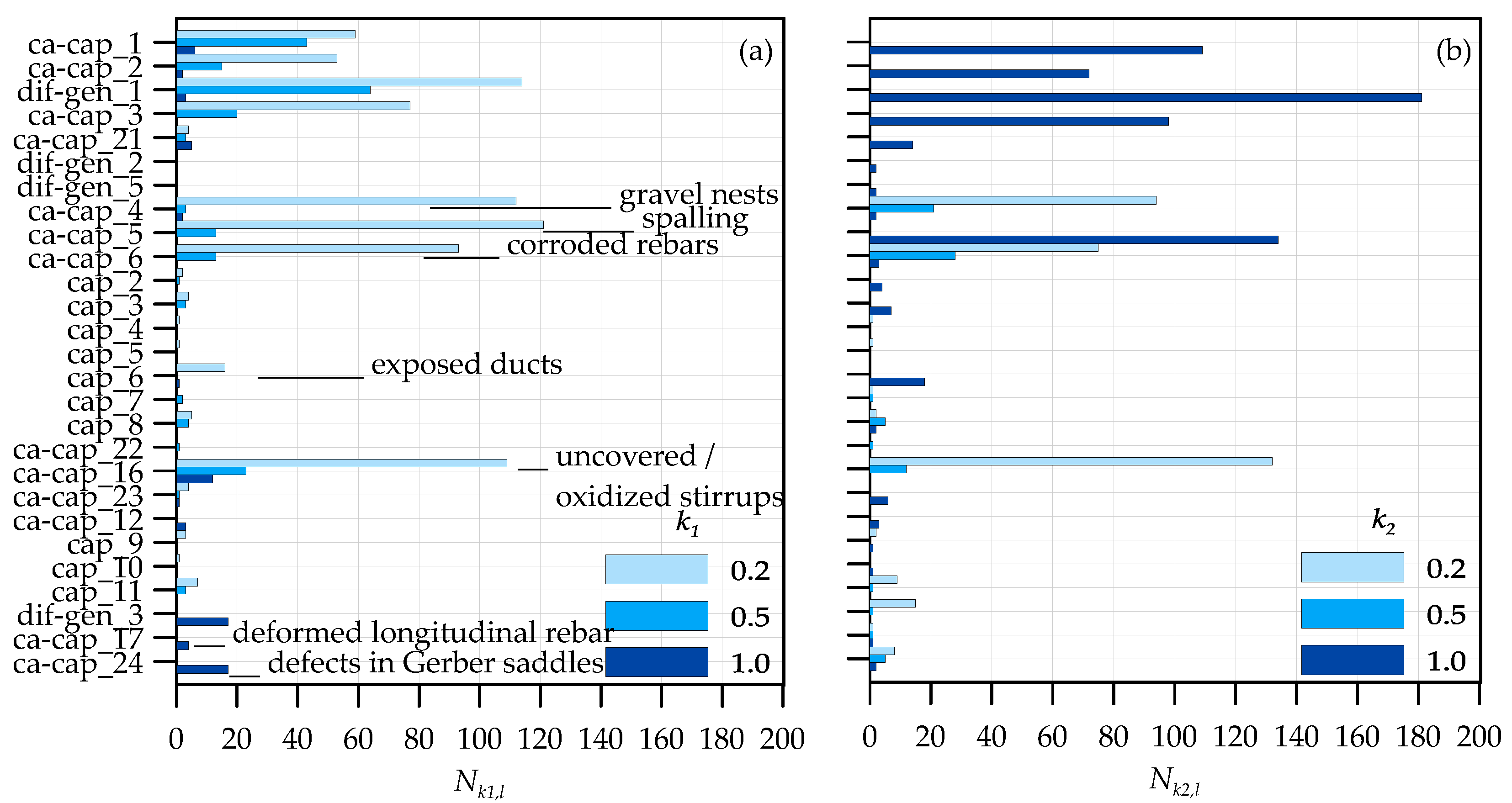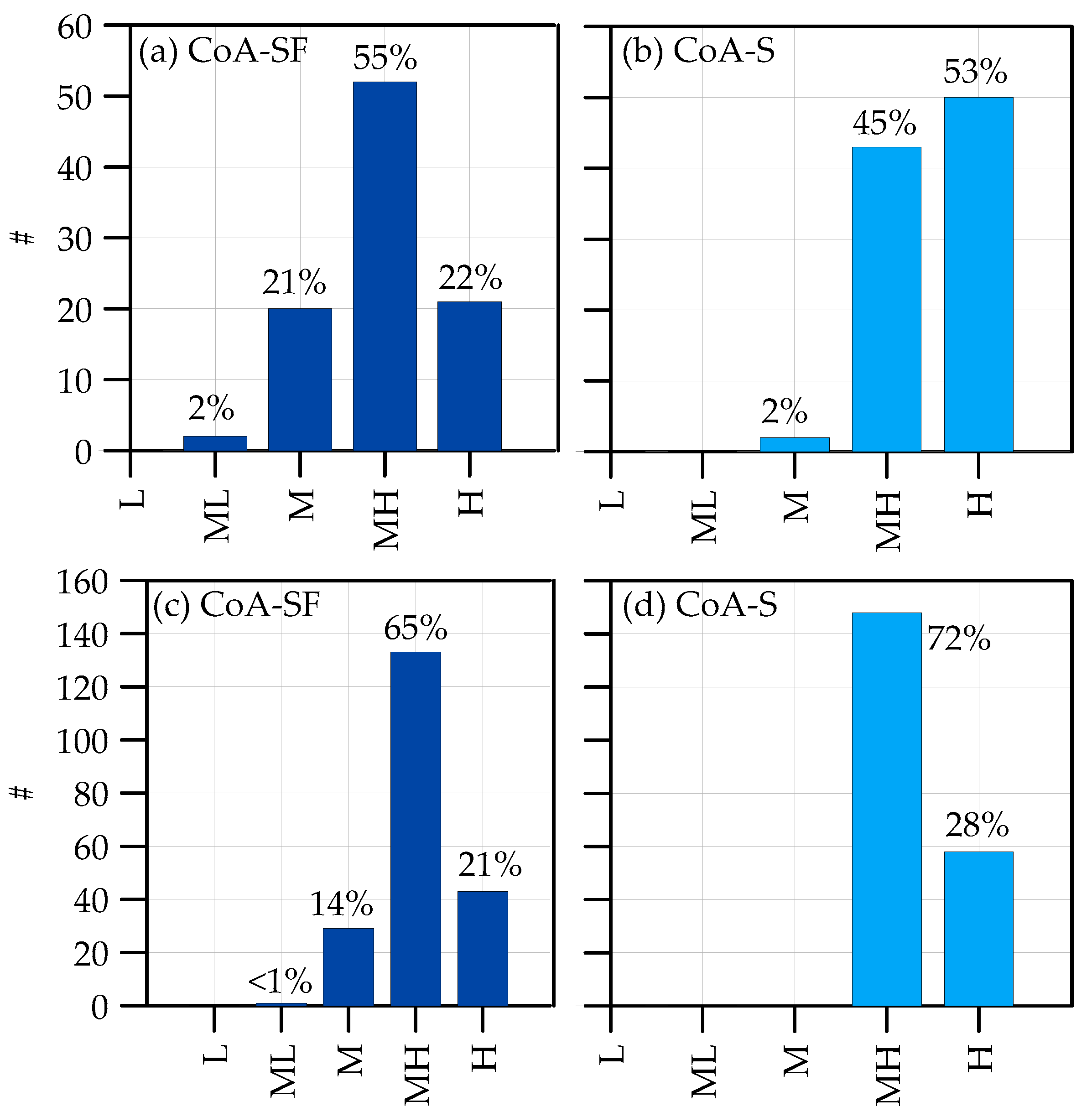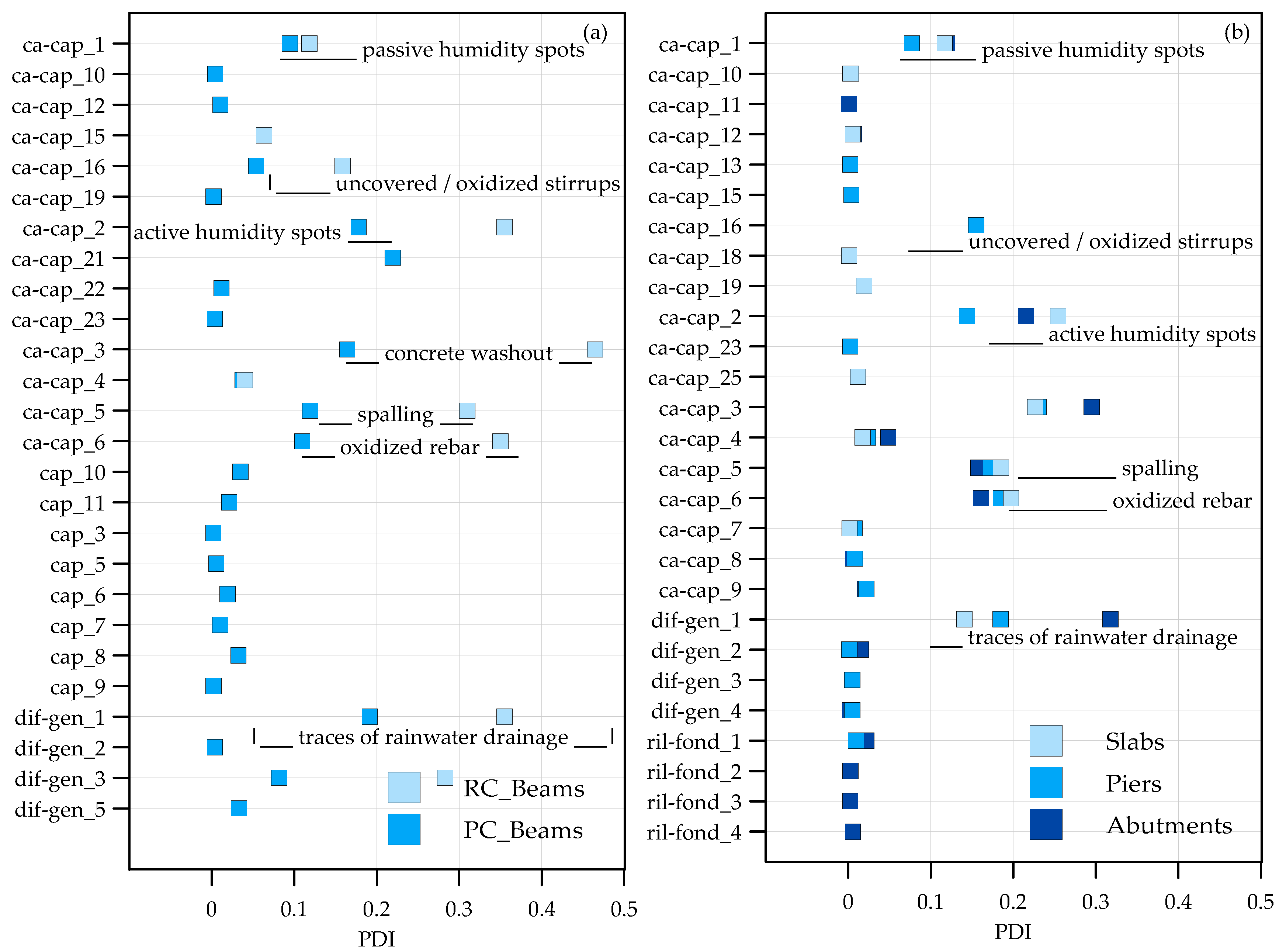Experimental Application of the Italian Bridge Guidelines to a Stock of Prestressed Concrete Bridges
Abstract
:1. Introduction
2. Overview of the IBGs for Existing Bridges
- -
- L0. Census of the bridges/viaducts of the road network under examination. This step involves the collection of basic information (e.g., geolocation, geometrical data, structural typology, design code) and the research and acquisition of documentation (e.g., executive drawings, calculation reports, documentation of previous maintenance works).
- -
- L1. Collection of the information needed to characterize the hazard (e.g., frequency of heavy vehicle traffic, intensity of the peak ground acceleration), the vulnerability (e.g., structural scheme, level of defectiveness) and the exposure (e.g., average daily traffic, presence of alternative paths) of the bridge for the risks under examination. At this level, visual inspections are required to collect the information concerning the state of conservation of the bridge. During the inspection, a qualified operator examines the structural and non-structural parts of the bridge/viaduct and fills in a checklist of pre-defined defects for each structural element, plus a form for all the non-structural elements. Also, the operator verifies the structural and geometric characteristics reported in the documentation of the bridge (if available), as well as the geomorphological and hydraulic properties of the involved area. In this phase, “Critical Elements” (CEs) of the bridge are identified by the inspector as the physical elements or conditions whose inherent fragility combined with a high level of defectiveness can impact the overall behavior of the bridge.
- -
- L2. Elaboration of the information collected in the previous levels though pre-defined logical flows to obtain the “Class of Attention” (CoA) for each of the four categories of risk [i.e., structural–foundational (CoA-SF), seismic (CoA-S), landslide (CoA-L) and flood (CoA-F)] and, finally, the synthetic value of the CoA. Based on the synthetic value of the CoA, a decision can be made on subsequent actions to be implemented (e.g., traffic limitation, further inspection campaigns, refurbishment interventions). In particular, specific inspection campaigns are mandatory for bridges with medium or medium-high CoAs, whereas accurate structural assessments (L4) are required for bridges with high CoA.
- -
- L3. Preliminary structural assessment of the structure in order to recognize the need for a detailed analysis of level L4. The numerical calculations required at level L3 aim to estimate the minimum safety level required by the codes at the time of construction of the bridge compared with the safety level required by the current Italian construction code (NTC18) [12].
- -
- L4. Accurate structural assessment of the bridge/viaduct according to NTC18 and the IBGs. The IBGs identify three different conditions —“passable”, “operative”, and “adequate”— for an existing bridge as a function of the vehicle load models and the safety level resulting from the L4 assessment. The “passable” condition is related to a maximum time of 5 years, during which the design and execution of safety works must be completed, and, contextually, the limitations of bridge utilization are applied. The “operative” condition is related to an assessment that is performed considering vehicle load models in a period of 30 years. Finally, the bridge is considered “adequate” when the requirements of NTC18 are satisfied.
- -
- L5. Accurate transportation assessment of the bridge/viaduct within the road network to which it belongs. This level of analysis is currently only established but not yet covered by the IBGs.
3. The Stock of PC Bridges
3.1. Database Collection
3.2. The Web Platform
3.3. Geometrical Properties of PC Bridges
4. Risk Analysis of the PC Bridges
4.1. Evaluation of the Level of Defectiveness
4.2. Calculation of the Classes of Attention
5. The Prioritization Defect Index
6. Conclusions
- -
- A preliminary check on the data collected by inspectors revealed systematic input errors and ambiguous data entry due to the numerous open questions proposed in the L0 and L1 forms. It is the opinion of the authors that a multiple-choice formulation of the questions proposed in the forms may be more appropriate in view of an automatic evaluation of the answers.
- -
- Critical Elements (CEs) are given a great weight in the determination of the Class of Attention (CoA) of the bridge. The IBGs provide a general definition and some examples of what a CE is but does not provide an exhaustive list of CEs, nor a correlation of CEs with the defects provided in the defect forms. According to the authors, this item has the potential to undermine the objective application of the IBGs since each inspection team is given the possibility to establish which group of defects is associated with one or more CEs. A possible solution would be to provide a list of defects associated with CEs for each structural typology and each CoA. In this paper, a list of defects associated with CEs was proposed in the case of multi-bay, simply supported PC bridges for the CoA-SF and CoA-S.
- -
- Although the initial version of the IBGs provide some differentiation in attributing the level of defectiveness between CEs associated with defects with a high grade of importance (G) or medium grade of importance, the extension or the intensity of the defect is not taken into account. However, it is worth of note that some recent procedural suggestions of the Italian National Agency for Railways, Road and Motorway Infrastructure Safety (ANSFISA) suggest a methodology to take into account the different levels of intensity and extension of defects.
- -
- The application of the methodology provided by the IBGs to the stock of 301 bridges led to the attribution of a high structural–foundational CoA (CoA-SF) in 21% of the examined bridges and a high Seismic CoA in 35% of the cases. This result means that detailed (and onerous and time-consuming) structural and seismic assessments are required for a large number of bridges.
- -
- A Prioritization Defect Index (PDI) was proposed as a decision-making tool for the planification of maintenance campaigns on large stocks of bridges. The PDI assumes a value in a range from 0 to 1, depending on the frequency with which a certain defect of importance G occurs in the sample with a given extension k1 and intensity k2. Defects with high values of the PDI should be the focus to design the subsequent maintenance campaign. This focus allows users to plan targeted interventions on the entire stock of bridges, minimizing the economic and social costs.
- -
- The development of more refined uses of PDI values by selecting groups of bridges affected by common defects and incorporating the properties of each structure in order to plan interventions targeted for groups of bridges or for a single bridge;
- -
- The integration of the other two hazards considered in the IBGs, i.e., floods and landslides.
Author Contributions
Funding
Data Availability Statement
Acknowledgments
Conflicts of Interest
References
- Zonta, D.; Zandonini, R.; Bortot, F. A Reliability-Based Bridge Management Concept. Struct. Infrastruct. Eng. 2007, 3, 215–235. [Google Scholar] [CrossRef]
- Limongelli, M.P.; Gentile, C.; Biondini, F.; Di Prisco, M.; Ballio, F.; Belloli, M. The Monitoring Guidelines of the Lombardia Region in Italy. Eng. Proc. 2022, 17, 16. [Google Scholar] [CrossRef]
- Limongelli, M.P.; Gentile, C.; Biondini, F.; di Prisco, M.; Ballio, F.; Zonno, G.; Borlenghi, P.; Bianchi, S.; Capacci, L.; Anghileri, M.; et al. Bridge Structural Monitoring: The Lombardia Regional Guidelines. Struct. Eng. Int. 2022, 20, 461–484. [Google Scholar] [CrossRef]
- Calvi, G.M.; Moratti, M.; O’Reilly, G.J.; Scattarreggia, N.; Monteiro, R.; Malomo, D.; Calvi, P.M.; Pinho, R. Once upon a Time in Italy: The Tale of the Morandi Bridge. Struct. Eng. Int. 2018, 29, 198–217. [Google Scholar] [CrossRef]
- Italian Ministry of Infrastructures and Transportations. D.M. 17 December 2020. Linee Guida per La Classificazione e Gestione Del Rischio, La Valutazione Della Sicurezza Ed Il Monitoraggio Dei Ponti Esistenti; Italian Ministry of Infrastructures and Transportations: Rome, Italy, 2020. [Google Scholar]
- Italian Ministry of Infrastructures and Transportations. D. M. 1 July 2022. Linee Guida per La Classificazione e Gestione Del Rischio, La Valutazione Della Sicurezza Ed Il Monitoraggio Dei Ponti Esistenti; Italian Ministry of Infrastructures and Transportations: Rome, Italy, 2022. [Google Scholar]
- Scalbi, A.; Zani, G.; di Prisco, M.; Mannella, P. The Role of Maintenance Plans on Serviceability and Life Extension of Existing Bridges. Struct. Concr. 2022, 24, 127–142. [Google Scholar] [CrossRef]
- Zizi, M.; Bencivenga, P.; De Matteis, G. Handling Policies for Italian Existing Bridges with a Territorial Approach: The Case Study of Caserta, Italy. Structures 2023, 48, 1306–1321. [Google Scholar] [CrossRef]
- Grieco, L.A.; Scattarreggia, N.; Monterio, R.; Parisi, F. An Index-Based Method for Risk Assessment of Existing Bridges Subjected to Multiple Hazard. In Bridge Maintenance, Safety, Management, Digitalization and Sustainability, Proceedings of the 12th International Conference on Bridge Maintenance, Safety and Management, IABMAS 2024, Copenhagen, Denmark, 24–28 June 2024; CRC Press: Boca Raton, FL, USA, 2024; pp. 2873–2881. [Google Scholar] [CrossRef]
- Grieco, L.A.; Scattarreggia, N.; Monteiro, R.; Parisi, F. An Index-Based Multi-Hazard Risk Assessment Method for Prioritisation of Existing Bridge Portfolios. Int. J. Disaster Risk Reduct. 2024, 114, 104895. [Google Scholar] [CrossRef]
- Costantino, G.; Messina, D.; Recupero, A.; Rossi, P.P.; Spinella, N. A Web Platform for Management and Analysis of Existing Bridges. Procedia Struct. Integr. 2023, 44, 1220–1227. [Google Scholar] [CrossRef]
- Italian Ministry of Public Works. D.M. 17 January 2018. Nuove Norme Tecniche per Le Costruzioni. Gazzetta Ufficiale; Italian Ministry of Public Works: Rome, Italy, 2018; Volume 42. (In Italian) [Google Scholar]
- Fox, M.J.; Furinghetti, M.; Pavese, A. Application of the New Italian Assessment Guidelines to a 1960s Prestressed Concrete Road Bridge. Struct. Concr. 2023, 24, 583–598. [Google Scholar] [CrossRef]
- Rossi, P.P.; Spinella, N.; Recupero, A. The Italian Guidelines for Risk and Safety Evaluation of Existing Bridges: A Case Study. In Bridge Maintenance, Safety, Management, Digitalization and Sustainability, Proceedings of the 12th International Conference on Bridge Maintenance, Safety and Management, IABMAS 2024, openhagen, Denmark, 24–28 June 2024; CRC Press: Boca Raton, FL, USA, 2024; pp. 2882–2889. [Google Scholar] [CrossRef]
- Rossi, P.P.; Spinella, N.; Recupero, A. Experimental Application of the Italian Guidelines for the Risk Classification and Management and for the Safety Evaluation of Existing Bridges. Structures 2023, 58, 105387. [Google Scholar] [CrossRef]
- Santarsiero, G.; Masi, A.; Picciano, V.; Digrisolo, A. The Italian Guidelines on Risk Classification and Management of Bridges: Applications and Remarks on Large Scale Risk Assessments. Infrastructures 2021, 6, 111. [Google Scholar] [CrossRef]
- Salvatore, W.; Uva, G.; Venanzi, I.; Mazzotti, C.; Morici, M.; Natali, A.; Dall’Asta, A.; Ubertini, F.; Mannella, P.; Lepori, L.; et al. Application of Italian Guidelines for Structural-Foundational and Seismic Risk Classification of Bridges: The Fabre Experience on a Large Bridge Inventory. Procedia Struct. Integr. 2024, 62, 1–8. [Google Scholar] [CrossRef]
- Borzi, B.; Ceresa, P.; Franchin, P.; Noto, F.; Calvi, G.M.; Pinto, P.E. Seismic Vulnerability of the Italian Roadway Bridge Stock. Earthq. Spectra 2015, 31, 2137–2161. [Google Scholar] [CrossRef]
- Spinella, N.; Gullì, S. A Web-Based Graphical User Interface for Some Opensees Commands. In Proceedings of the 2022 Eurasian OpenSees Days; Lecture Notes in Civil Engineering; Springer: Cham, Switzerland, 2023; Volume 326 LNCE, pp. 326–333. [Google Scholar] [CrossRef]
- Miluccio, G.; Losanno, D.; Parisi, F.; Cosenza, E. Traffic-Load Fragility Models for Prestressed Concrete Girder Decks of Existing Italian Highway Bridges. Eng. Struct. 2021, 249, 113367. [Google Scholar] [CrossRef]
- Nettis, A.; Nettis, A.; Ruggieri, S.; Uva, G. Corrosion-Induced Fragility of Existing Prestressed Concrete Girder Bridges under Traffic Loads. Eng. Struct. 2024, 314, 118302. [Google Scholar] [CrossRef]
- Minnucci, L.; Scozzese, F.; Carbonari, S.; Gara, F.; Dall’Asta, A. Innovative Fragility-Based Method for Failure Mechanisms and Damage Extension Analysis of Bridges. Infrastructures 2022, 7, 122. [Google Scholar] [CrossRef]
- Santarsiero, G.; Masi, A.; Picciano, V.; Musano, A. Preliminary Assessment of Pre-1980 Girder Bridges in the Framework of the Italian Guidelines. Procedia Struct. Integr. 2024, 62, 121–128. [Google Scholar] [CrossRef]
- Rossi, P.P.; Spinella, N. Protocol of Investigations for the Preliminary Assessment of the Structural Safety of Highway Overpasses. Structures 2024, 70, 107609. Available online: https://www.sciencedirect.com/science/article/pii/S2352012424017624 (accessed on 27 October 2024). [CrossRef]
- Colajanni, P.; Recupero, A.; Ricciardi, G.; Spinella, N. Failure by Corrosion in PC Bridges: A Case History of a Viaduct in Italy. Int. J. Struct. Integr. 2016, 7, 181–193. [Google Scholar] [CrossRef]
- Anania, L.; Badalà, A.; D’Agata, G. Damage and Collapse Mode of Existing Post Tensioned Precast Concrete Bridge: The Case of Petrulla Viaduct. Eng. Struct. 2018, 162, 226–244. [Google Scholar] [CrossRef]












| Code | Description | Code | Description |
|---|---|---|---|
| dif-gen_6, G = 5 | piers or abutments out of plomb | ca-cap_13, G = 4 | presence of rushing cracks |
| ril-fond_1, G = 5 | movements undermining bridge foundations | ca-cap_17, G = 5 | bending of rebars |
| ril-fond_5, G = 5 | movements of the foundation | ca-cap_24, G = 5 | defects on Gerber saddles |
| cap_7, G = 4 | worn sheaths and oxidation of prestressing wires | app_3, G = 4 | blockage of the bearing |
| cap_8, G = 4 | exposed and oxidated prestressing wires | app_6, G = 4 | squashing of plumb bearings |
| cap_9, G = 5 | cross-section reduction in prestressing reinforcement | app_8, G = 4 | excessive lateral deformation of rubber bearings |
| cap_12, G = 5 | breakage of prestressing bars or anchorage failure | app_9, G = 4 | squashing of rubber bearings |
| ca-cap_10, G = 5 | presence of diagonal cracks | app_13, G = 4 | loss of circular shape of roller bearings |
Disclaimer/Publisher’s Note: The statements, opinions and data contained in all publications are solely those of the individual author(s) and contributor(s) and not of MDPI and/or the editor(s). MDPI and/or the editor(s) disclaim responsibility for any injury to people or property resulting from any ideas, methods, instructions or products referred to in the content. |
© 2024 by the authors. Licensee MDPI, Basel, Switzerland. This article is an open access article distributed under the terms and conditions of the Creative Commons Attribution (CC BY) license (https://creativecommons.org/licenses/by/4.0/).
Share and Cite
Floridia, A.; Messina, D.; Panarelli, D.; Recupero, A.; Rossi, P.P.; Spinella, N. Experimental Application of the Italian Bridge Guidelines to a Stock of Prestressed Concrete Bridges. Infrastructures 2024, 9, 196. https://doi.org/10.3390/infrastructures9110196
Floridia A, Messina D, Panarelli D, Recupero A, Rossi PP, Spinella N. Experimental Application of the Italian Bridge Guidelines to a Stock of Prestressed Concrete Bridges. Infrastructures. 2024; 9(11):196. https://doi.org/10.3390/infrastructures9110196
Chicago/Turabian StyleFloridia, Andrea, Davide Messina, Dario Panarelli, Antonino Recupero, Pier Paolo Rossi, and Nino Spinella. 2024. "Experimental Application of the Italian Bridge Guidelines to a Stock of Prestressed Concrete Bridges" Infrastructures 9, no. 11: 196. https://doi.org/10.3390/infrastructures9110196
APA StyleFloridia, A., Messina, D., Panarelli, D., Recupero, A., Rossi, P. P., & Spinella, N. (2024). Experimental Application of the Italian Bridge Guidelines to a Stock of Prestressed Concrete Bridges. Infrastructures, 9(11), 196. https://doi.org/10.3390/infrastructures9110196







